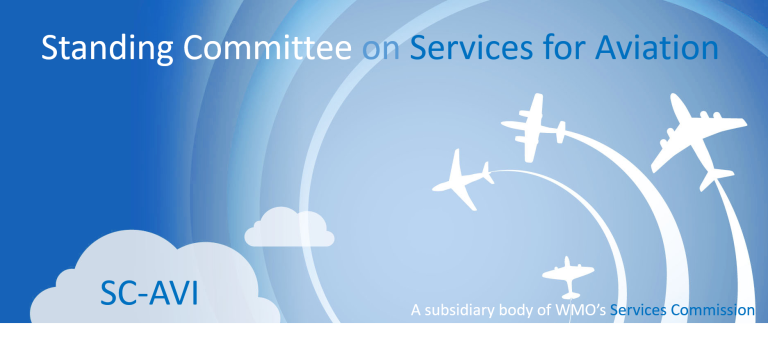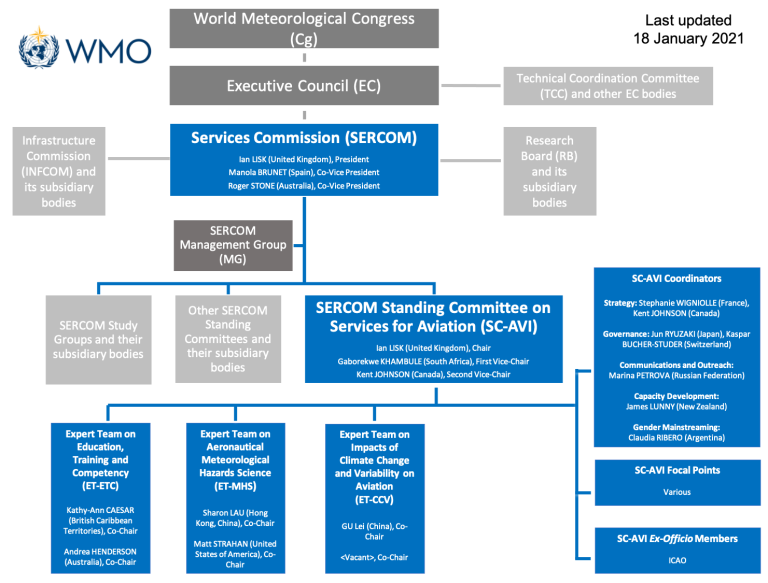Aviation | Governance | SC-AVI

Jump to: Background | Governance | Purpose | Expertise | Membership | Duration and Modalities of Work | Outputs | Reports | Subsidiary Bodies | EliosCloud Collaboration Platform
Background
Consistent with the outcomes of the Eighteenth World Meteorological Congress (Cg-18) held in 2019 as they pertain to the WMO Strategic Plan, Operating Plan and Governance Reform (WMO-No. 1236 refers), through Resolution 3/1 (SERCOM-1) of the First Session of the Commission for Weather, Climate, Water and Related Environmental Services and Applications (the 'Services Commission' or SERCOM) held in 2020, the Organization established, inter alia, a Standing Committee on Services for Aviation (SC-AVI) for the period 2020 to 2023.
Governance
The SC-AVI is a subsidiary body of the Services Commission (SERCOM) and, accordingly, reports to SERCOM on a routine basis. Information on SERCOM is available here.
The SC-AVI itself comprises several subsidiary bodies in the form of Expert Teams (ETs). Details on the nature, composition, activities and deliverables of the SC-AVI ETs is available here.
The organizational chart for SC-AVI is as follows (click here open/enlarge in a new window)

The following sections provide information on the purpose, expertise, membership, duration, modalities of work and outputs of SC-AVI. In addition, access to the reports of SC-AVI is provided.
Any questions pertaining to SC-AVI, its parent or subsidiary bodies can be directed to the WMO Secretariat via aviation wmo [dot] int (email).
wmo [dot] int (email).
Purpose
(A) To contribute, in close collaboration with the International Civil Aviation Organization (ICAO) and other partners and consistent with the implementation of the WMO Strategic Plan, to furthering the international standardization of meteorological services for international air navigation and to provide assistance to Members with aeronautical meteorological services to achieve compliance with those standards.
(B) To promote and facilitate, in collaboration with the WMO regional associations and other relevant WMO constituent bodies, the international sharing of implementation experience and good practice, uptake and exchange of scientific and technological advancement (including pilot projects where appropriate) to meet evolving user requirements for high-quality, borderless, harmonized and cost-effective aeronautical meteorological information and services.
(C) To co-lead, with ICAO and other relevant stakeholders, the long-term planning and development of enhanced aeronautical meteorological information and services in support of the future globally interoperable, harmonized air traffic management system, and additionally, to support the integration of meteorological information (including observations, forecasts, warnings and alerts) into air traffic management systems and decision-support, including transition of new capabilities into operational and impact-based information services enabled by the science-for-services value chain and projects such as AvRDP (Aviation Research and Development Project).
(D) To analyse, in collaboration with SC-CLI and/or other relevant WMO bodies, the impacts of climate change and variability, including extreme weather and climate events, on aviation operations on the ground and in the air and clearly communicate these impacts proactively to ICAO and other relevant stakeholders.
(E) To promote, in cooperation with ICAO, regional bodies and Members, efficient and effective governance of aeronautical meteorological service provision through the development and/or enhancement of appropriate cost-recovery mechanisms (including for regional and sub-regional service provision), information and data exchange policies and good practices.
(F) To develop, in collaboration with relevant WMO programmes as well as ICAO, guidance, training material and other educational/learning outreach to assist Members in the implementation of quality management systems and compliance with the competency and qualification requirements of personnel providing meteorological service for international air navigation, with an emphasis on developing and least developed countries.
(G) To respond to Members’ aeronautical meteorology prioritized needs and support capacity development activities, in cooperation with WMO regional associations, ICAO and other relevant partners, aiming to enhance the delivery of fit-for-purpose, high-quality, borderless, harmonized and cost effective aeronautical meteorological services, particularly within developing and least developed countries.
(H) To enhance, through effective communication and outreach, global and regional collaboration and partnership in aeronautical meteorology amongst Members and their aeronautical service providers, aviation stakeholders and other partners.
(I) To provide advice, upon request, to INFCOM and its subsidiary bodies on the benefits of aircraft-based meteorological observations, including those derived through the WMO AMDAR programme, to improve services for aviation.
Expertise
- Meteorology and related sciences including climatology.
- Volcanology and related sciences including geophysics and geodesy.
- Space physics and aeronomy including space weather.
- Meteorological and other environmental hazards, such as releases of radioactive material and other toxic chemicals, with impacts on aviation.
- Aeronautical meteorology service delivery including for observations/reports, forecasts, warnings/alerts and advisories.
- Cost recovery and governance of aeronautical meteorological services.
- National and international civil aviation regulations.
- Aviation operations (ground and air) and associated aviation user requirements.
- Observing and forecasting systems design and operation, including but not limited to weather radar and meteorological satellite remote-sensing, nowcasting and short-range prediction, plus training thereon.
- Meteorological codes and data representation.
- Information management and information exchange systems.
- Artificial intelligence and machine learning technologies.
- Quality management systems and (aviation) safety management systems.
- Education and training, competency and qualification of personnel.
- Communications and outreach.
Membership
Members:
- Chair [Ian Lisk, United Kingdom of Great Britain and Northern Ireland]
- First Vice-Chair [Gaborekwe Khambule, South Africa]
- Second Vice-Chair [Kent Johnson, Canada]
- Leads and/or co-leads of SC-AVI subsidiary bodies
- SC-AVI Coordinators
- ICAO representatives (ex-officio)
Observers:
- Other technical experts may be invited, on a needs basis, to serve as Observers on the Standing Committee, as determined by the chair/vice-chair of the Standing Committee in consultation with the president of the Services Commission
Duration and Modalities of Work
- Until the next ordinary session of the Services Commission where, if required, the Standing Committee can be re-established at the discretion of the Services Commission
- Meetings
- Tele/video conference
- Correspondence including email exchanges and other appropriate online interactions
Expected outputs
(A) Updated education and training Moodle or equivalent platform supporting the implementation of, inter alia, quality management systems, personnel competency and qualification requirements in aeronautical meteorology.
(B) New or updated WMO technical regulations and supporting guidance, including Volume I, General Meteorological Standards and Recommended Practices and Volume II, Meteorological Service for International Air Navigation (WMO-No. 49).
(C) Updated WMO long-term plan for aeronautical meteorology.
(D) New or updated performance metrics, validation methodologies and service delivery good practices for new and enhanced meteorological services for aviation addressing hazardous meteorological conditions (including icing, turbulence and convection) and other phenomena (including volcanic ash, volcanic sulphur dioxide, radioactive material and space weather).
(E) New or updated models of good practice on the cost recovery of aeronautical meteorological service provision, including in respect of regional and global service.
(F) Updated WMO Rolling Review of Requirements Statement of Guidance on Aeronautical Meteorology.
(G) New or updated roadmap for the Aviation Research and Development Project (AvRDP) agreed with Research Board.
(H) Recommendations for scientific research and development and modes of service delivery good practice developed jointly with Research Board.
(I) Report on the climatological variations of aviation hazards, including extreme weather and climate events, and their impacts on aviation operations.
(J) Report on climatological variability parameters of interest to aviation stakeholders.
(K) Gender action plan and associated framework to empower women in leadership within the aeronautical meteorology community.
(L) Periodic community newsletters detailing national and international developments, events and activities concerning services for aviation.
Reports
The SC-AVI convenes quarterly video-teleconferences and periodic (usually annual) face-to-face meetings. The reports arising from the face-to-face meetings are publicly available here.
Subsidiary bodies
The SC-AVI comprises the following subsidiary bodies:
- Expert Team on Education, Training and Competency (ET-ETC)
- Expert Team on Aeronautical Meteorological Hazards Science (ET-MHS)
- Expert Team on Impacts of Climate Change and Variability on Aviation (ET-CCV)
Click on the links above to find our more information about each of these SC-AVI ETs.
In addition, SC-AVI is supported by a number of Coordinators and Focal Points.
EliosCloud Collaboration Platform
The SC-AVI EliosCloud collaboration platform (member access only) is accessible here.
CLICK HERE to return to our homepage
